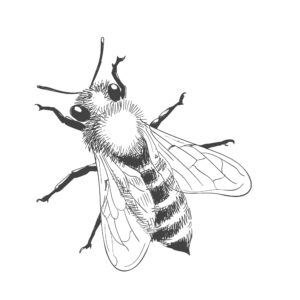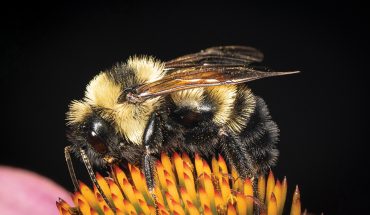As s a honeybee take its final drink, bittersweet memories arrive and depart
by Jim Dodson
I’ve been thinking about time lately. How quickly it comes. How quickly it passes. Like this year, for example, rapidly drawing to close.
November is a month of remembrance. We begin by celebrating Hallowmas, the Feast of All Saints known and unknown. In the middle of the month we’ll remember veterans for their sacrifice and wind up November by giving thanks for the abundance of the Earth and ties that bind. The good news this holiday season is that families may finally be able to gather in person to celebrate Thanksgiving and Christmas, though collective reflection upon the millions worldwide who are no longer with us this year reminds us of life’s precious brevity.
Speaking of such, the other afternoon, cheered by the sudden arrival of autumn light and a breath of welcome coolness, I noticed a small honeybee having a drink of water from an old bird bath I’ve kept filled on account of our lingering summer. Recently, I placed a circle of small stones at the water’s edge to prevent thirsty bees from falling in and drowning. Until my wife informed me that drowning is a genuine threat to the invaluable life of bees, I never gave passing thought to how a simple drink of water could be so perilous.
In ancient times, bees were considered symbols of order and immortality. The wax they produce found its way into candles used in religious ceremonies, their honey sweetened and preserved food. Coins from the fifth century featured images of bees, held to be among nature’s most magical creatures.
Modern science, in fact, confirms what ancient observers believed about bees — that they have a mysterious yet highly refined way of communicating with each other that enables them to find the hidden nectar of flowers and construct honeycombs from thousands of symmetrically perfect hexagons, mathematical structures reminiscent of the six-pointed stars that form the Flower of Life.
“Because bees feed on the nectar of flowers,” writes symbologist Adele Nozedar, “and fundamentally on sunlight, they are agents of transmutation, making something from nothing, mystical creatures that are able to foresee the future.” This belief, she adds, may explain why beekeepers since the late Middle Ages have followed the tradition of speaking to their honeybee hives, conveying news of the household, particularly of births and deaths, and the broader life of the community.
Between us, I lost track of time watching this lone honeybee pause to refresh. Either five minutes or the better part of an hour drifted by. The bee was in no hurry and neither was I, both taking our own sweet time as the clock of another year winds down, though his days are ten thousand times shorter than mine, a bittersweet reminder to get on with things that need to be done.
As I watched him hop from stone to stone, I wondered where he might be headed and how much time he has left to fulfill his purpose. A male honeybee lives anywhere from one month to seven weeks, on average, and suddenly it was autumn. I felt a stab of sadness for my thirsty friend, but he rose into the air, hovered for a moment, then flew away. My impression was that he knew exactly where he was headed and why he is here. Isn’t that the greatest lesson of being alive?
Remembrance often comes with bittersweet memory. Still sitting where the honeybee left me, I randomly opened an old leather journal — ironically embossed with the Celtic Flower of Life, purchased years ago in a Dublin book shop — where I keep a record of travels, eccentric thoughts, favorite quotes, overheard comments, mildly blue jokes, and notes on my garden, only to be stopped by a line I wrote two days before Thanksgiving last year.
For the first time ever, due to COVID distancing, none of our grown children could make it home for the holiday. That was disappointing enough — a moment we expected to eventually come in time as their busy lives expanded — but the unexpected loss of our sweet and lovable golden retriever, Ajax, a gift to my wife for our 10th anniversary, was a devastating blow. Due to a swift malady that came out of nowhere overnight and left us no choice but to humanely put him down, a kind veterinarian came to the house to administer relief as he lay calmly on his favorite couch, gazing out the window at the yard where he loved to romp with the kids. He was such a big kid himself, I called him “Junior.”
After I carried Junior’s body out to the doctor’s car, I sat at the top of my office steps by the garage and watched the beautiful light of a perfect autumn afternoon leave the world as peacefully as my friend Ajax had just done. The mighty white oaks around us had shed most of their leaves by then, though a few last ones filtered to earth in the golden light. I heard children’s voices just yards away, playing tag, squeals of terrified delight. Junior would have loved that. I looked up and saw a red-tailed hawk cruising over the treetops, tilting to the west as if turning toward home. I wondered what he saw from 200 feet closer to heaven. Perhaps an old dude sitting at the top of his steps, grieving for his friend who brought such joy into the world.
It’s probably about time I let my grief for Junior go. The light in the eye grown dim, wrote Walt Whitman, shall duly flame again.
Though I doubt that will happen just yet.
__
This article originally appeared in the November, 2021 issue of WALTER Magazine




